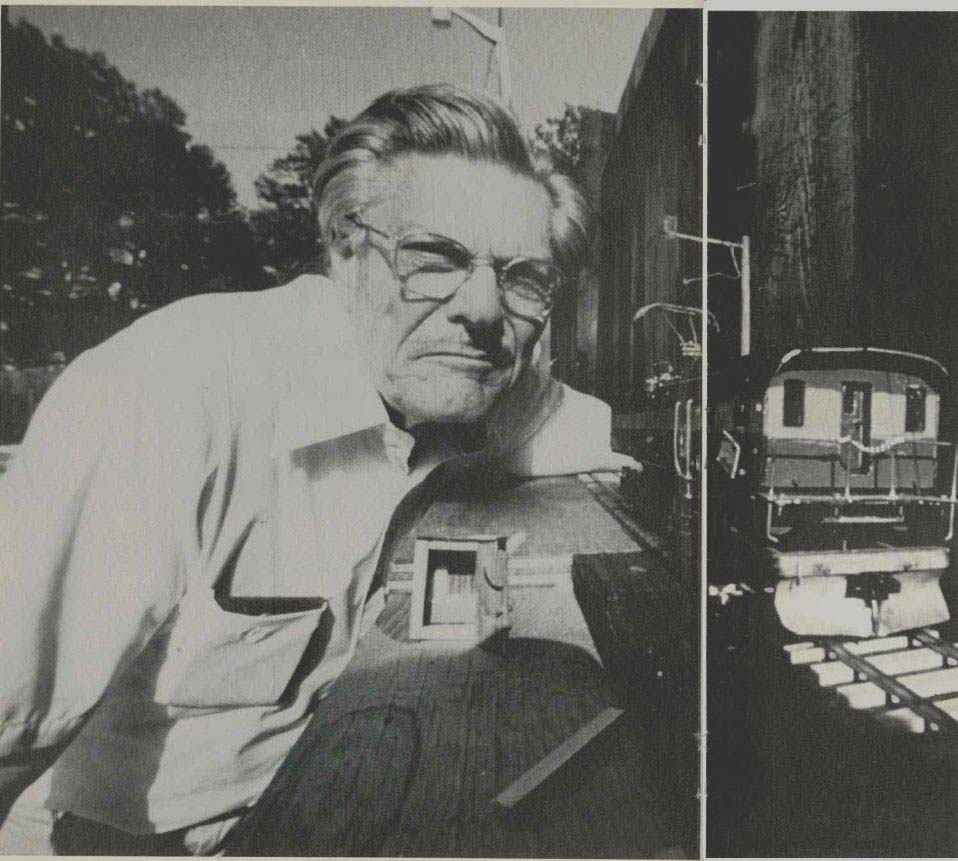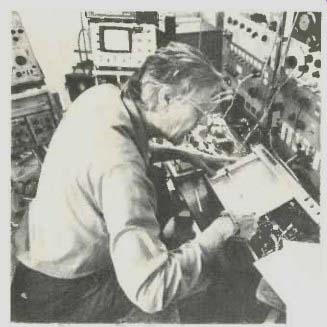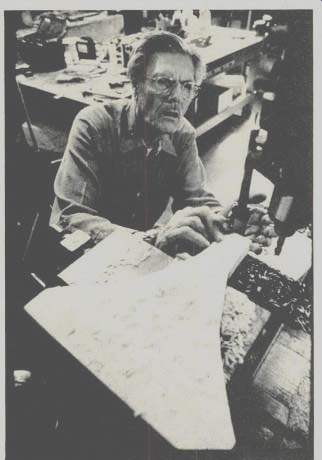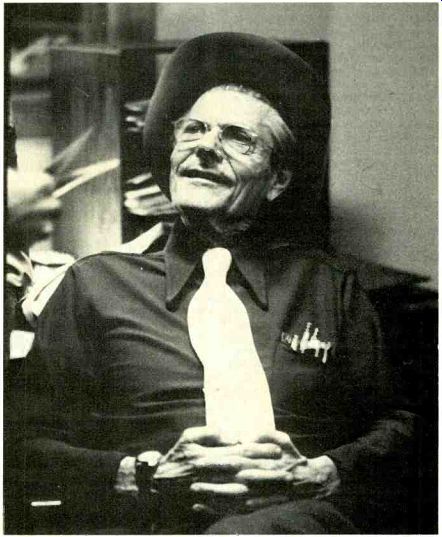
by Bob Browne & Gary Stock
"As far as I'm concerned, since 1940 the advances in loudspeakers have been largely in detail rather than in basic principle."

January 14, 1980. I'm on my way to Hope, Arkansas (population 8,800) to talk
with Paul Wilbur Klipsch, a man apparently so fascinating and so eccentric
that no one who hears the tales about him can separate fact from fiction. The
trip begins characteristically: I'm met at the Texarkana airport by a tobacco-chewing,
unshaven, Stetson-crowned fellow who looks as if he has been in the middle
of the Hatfield-McCoy feud for 20 years. He carries the moniker "T.C."--for
Tommy Crouch--and just happens to be the Executive Vice President of Klipsch
and Associates. Early on I realize that T.C.'s hayseed drawl covers an ability
to cut the wheat from the chaff quicker than most, and I learn to treat him
with the same deference I'd show to Swifty Lazar or a top Wall Street attorney.
Most of the Klipsch management is like that.
===========

The Wit and Wisdom of O. Gadfly Hurtz (a.k.a. Paul Klipsch)
On Brand Recognition--"I had a local woman apply for a job here once thinking we made paper clipsch. She probably still does."
On Colorful Metaphor--"You shoulda heard the first Heresy we made. It was very small, had an 8-inch woofer, and went down to 75 Hz solid as the brick outhouse be hind Buckingham Palace." On Mozart--"Oh yeah, that guy who died young and wrote all the music."
On Personal Appearance--"I shaved off my beard three years or so ago; it wasn't growin' right to look like Santa Claus and I couldn't trim it to look like Uncle Sam, so I had no choice."
On Local Public Relations--"It was gettin' kinda quiet around here one day, so I took a chunk of foam rubber, cut it and painted it to look like a brick, went into town, and made a big show of heavin' it at the front window of the best chowhouse in town. Kinda livened things up, and it was fully legal besides."
On Engineering--"In specifications, Murphy's Law supersedes Ohm's."
On Language--"How the hell can a plane land on water? It has to alight on water. People are always telling me things that just can't be true. They're talkin' about original copies, permanent change, modern nostalgia, rubber corks, plastic glasses, unlisted stock lists, and copper soldering irons. Wish they'd figure out what they were sayin'. (They should look up the word 'oxymoron' in any dictionary.)"
On Horn Design--"Simple. A horn is just a reasonably rigid boundary for an air column. Now all you have to do is figure what shape to make it."
===========
T.C. tells me I'm staying at the Klipsch Compound. Sounds foreboding until we arrive there, and I find it to be a rather luxurious upper middle class home, equipped with the amenities that are apparently most important in Hope--300 assorted beers in the fridge and a mega-sound system capable of knocking over NFL linebackers at a hundred paces. My ears ring for the remainder of the evening.
I meet the leader the day after I arrive, not knowing whether to expect a rip-roaring cowboy with a slide rule in his holster or just a slightly rusticated Werner von Braun. The initial impression is that Klipsch, all six foot-three of him, is both, with a healthy dose of knee-slapping wit thrown in for good measure. His humor is too broad and too relentless to be called "whimsey"; it's closer to that of a Country and Western stand-up comic. As I wander through the factory and through PWK's life, evidence of his quest for a good laugh is everywhere. There's a beer tap bolted to the instrument pan el of his airplane, an aircraft altimeter on one of his living room Klipschorns, and a huge manifold pressure gauge (perhaps from a railroad locomotive) on the dash of one of his cars. A real revolver in his living room has a barrel that curves around and points toward the user. He calls his dealer newsletters "Dope from Hope." A sign on the wall of his incredibly messy office notes "A clean, uncluttered desk is a sign of a sick mind." Two hundred feet of "O" gauge model railroad track, fully operable, surround his house. And he wears three watches--one set to Greenwich Mean Time and the others to various time zones.
Hope, Arkansas seems the perfect place for a man like Klipsch. It's a fairly typical Southern small town: A few motels, a multitude of gasoline stations, poor FM reception, and no movie theater. Last year it produced the world's largest watermelon, a monster that strained the scales at over 200 pounds. Chicken farming is big too.
On a particularly hot day, I'm told, the smells of chicken butchering, chicken frying, and chicken manure permeate the air outside the Klipsch factory with an odor both insufferable and unique (at least in this section of the world) to Hope. One of the local gas stations is even called "Hep Ur Sef." Most of the townspeople call Klipsch "Powel," although one gas-station attendant, asked for directions, scratches his head with a sly grin and says "Oh, you mean that cuckoo who makes the radios." But what about the man, his extraordinary past, and his company? Puzzling out any of the three is a bit harder than catching the tangy but amicable flavor of Hope and the Klipsch staff. As I pieced it together during my weeklong visit, Klipsch is of Scottish and German descent, his ancestors having come to the United States about 1830. Born in 1904 (he is one of the few active engineers who remembers the invention of the loudspeaker and the development of the first working vacuum tubes), he took dual degrees in electrical engineering--one in 1926 and another in 1934--served in the Army during the Second World War, during which he did research in Hope, came to like its country ways, and first caught the acoustics bug. His first year in business, 1946, was in a tin shed behind a local laundry. In 1948 there were 30 Klipschorns produced.
The company became a real force in hi-fi in the Sixties and began a serious international marketing effort. Klipsch & Assoc. has grown at an annual rate of about 20 percent--thoroughly respectable for a mature manufacturing organization--and has, in the past few years, begun to involve itself seriously in the professional sound field, with a complete line of sound-reinforcement loudspeakers. Klipsch notes with obvious satisfaction that his largest pro-sound speaker, the MCM 1900, is capable of generating an acoustic gale of 141 dB SPL when connected to a BGW "Arc Welder" power amplifier.
Klipsch himself still presides over the company's operations and travels with his much younger associates to dealers and shows worldwide. His hectic daily schedule typically begins with 1 1/2 miles of jogging or swimming (his swimming pool, designed by him, is a precise 1/44 of a mile long), and ends after dark. Klipsch is a rather religious man--he says grace at every meal with a ring of hands around the table--as well as a sociable one; he has been a Mason, a Rotarian, and a Shriner for more than 25 years.
He is rated in the "Expert Class" in marksmanship with his cap-and-ball Ruger pistol. He also holds a number of patents in the firearms field and is an instrument-rated private pilot of long standing. At 76, he shows few signs of slowing down. He remains extremely active in the Audio Engineering Society (which awarded him its Silver Medal two years ago), where he has won a reputation as an outrageously funny curmudgeon given to ten-gallon hats and yellow buttons and to dismissing many revisionist engineering ideas as all "manure and molasses." He loves trains with all the fervor of a schoolboy. He wakes his family with reveille played at ear-splitting levels on his cornet each Sunday, and then serves his infamous beer pancakes. Klipsch, in short, is an American original--a little Edison, a little Lindbergh, a little Will Rogers, all rolled up and formed into a six-foot-plus cowboy with wire-rimmed glasses and a taste for life.
Klipsch and his wife Valerie drive me to the Texarkana airport after church on Sunday, and say goodbye as though I were a son going off to war.
My last glimpse of him has him staring quizzically at the sky as another small aircraft passes over. He has told me about a new type of plane he'd like to build--something Called a "Canard." He's probably figuring out how to make it as I taxi down the runway.
-Bob Browne
================

After Bob Browne's visit to Klipsch and Associates, Contributing Editor Gary Stock interviewed PWK on the technical side of Klipsch's thinking. Here too he shows himself to be an American original--controversial, humorous, and fiercely independent.
Audio: What are the major advancements--the significant individual steps--that you feel have moved loudspeaker design forward since the days of Rice and Kellogg, the two engineers who developed the first moving-coil loudspeaker?
Klipsch: One big step was in 1914 or so when A.G. Webster formulated the idea that a horn of exponential flare rate comprised the most efficient de sign for a horn. He proved mathematically that the exponential shape gave the maximum performance for a unit of bulk. Then two Westinghouse engineers, Slepin and Henna, published a paper in 1924 in which they independently developed the idea of the exponential horn. A Dr. Karapetoff of Cornell took them to task for failing to refer to the earlier work, by the way, noting as an aside that he had been in Webster's laboratory during the early stages of his work and that Webster had apparently showed him two horns, one of plaster and one of brass.
Webster challenged Karapetoff to hear the difference, and the latter later said "I accepted the challenge and he won," bringing up the question of whether the sound was generated by an early loudspeaker, by a vibrating reed, or what. The point, however, is that once the sound was generated, it propagated equally well through horns of two different materials. That establishes one of the basic tenets of horn design. Simple, a horn is just a reasonably rigid boundary for an air column. Now all you have to do is figure what shape to make it.
Sandeman, of England, invented and patented a corner horn in 1934, and my own contribution in 1940 was to further reduce the total bulk required for a wide-range horn loudspeaker. As far as I'm concerned, since then the advances in loudspeakers have been largely in detail rather than in basic principle.
Audio: You've stated your basic philosophy on loudspeaker design in many places, but could you give us a brief review of it here? What should a loudspeaker do in order to be good?
Klipsch: The first point is that the higher the efficiency, the lower the distortion. This is something that can be pretty well proven technically, though I'm not going to prove it here.
Power output with low distortion are the two primary criteria. You can put one first and the other second, either way, since after all the two are directly related mathematically. Third in importance is the polar pattern, whether the speaker radiates into the angle you want to cover. And last, probably least important, is the effective frequency response.
Audio: Then you view the response curve as the least important of those criteria?
Klipsch: Yes. What you really buy in a loudspeaker is horsepower output. In horn loudspeakers the efficiency--the horsepower output, call it--is typically one to three orders of magnitude higher and the distortion proportionately lower than in a direct radiator. Admittedly, the direct radiator is the less expensive, "cost effective" approach, and it will never be replaced because horns are vastly more expensive to build. But if you look at it in terms of horsepower per unit cost, then the horn suddenly becomes much more cost effective--raising the point that the total music system may cost less for a given level of performance if the speakers cost more and yet require a much smaller amplifier. This brings in my much-quoted remark that what this country needs is a good five-watt amplifier.
Audio: What should a speaker do in order to be popular with the general public? Are most buyers looking for accuracy of reproduction?
Klipsch: First off, I don't even consider myself a member of the general public. I know that my own requirements in a loudspeaker are those I've discussed. Judging from what contact I have with the general public, though, I conclude that 99 percent of the general public doesn't even know what ac curacy of reproduction is. My company is for the one percent composed of perfectionists who buy these expensive speakers.
Audio: How do you react to the statements by some audio enthusiasts that all horn-type speakers have intrinsic coloration--a particular sonic character, as it were, that is inherently unnatural sounding?
Klipsch: Many years ago I recall reading an article about the retirement of David Sarnoff as the Chairman of the Board of RCA. He was reminiscing in the story about one of the earliest electric phonographs, developed by Victor just after it had been acquired by RCA. It sounded miles better than the phonographs of the day, but Sarnoff remembers someone in marketing listening to it and saying "I don't think it will sell; it doesn't sound like a phonograph." There's a good point there: Many people would prefer that a music-reproduction system sound like a machine, rather than like music.
If you take any kind of speaker--horn or direct radiator--lop off the lows below 300 Hz, attenuate the up per treble, and inject some scratchiness, people will say "it sounds like a horn." That's because it has a restricted frequency range; it--would be like using one of our Klipschorns with only the midrange driver connected. It would sound like a Twenties phonograph. The point I'm making is that so called horn coloration is a function of the frequency response. A wide-range horn, like any of the speakers we make, will have no substantial coloration. You can make any horn sound like any direct radiator, if they both have wide, flat frequency response. But the horn will always sound cleaner because it will always have higher out put for lower distortion. That's why I'm in the business of making horn speakers.
(adapted from Audio magazine, Aug. 1980)
Also see:
The Mud Factor by Paul W. Klipsch (Oct. 1970)
That Damping Factor (by Paul W. Klipsch) (Mar. 1970)
Edwin Armstrong--GENIUS INVENTOR (Nov. 1980)
= = = =